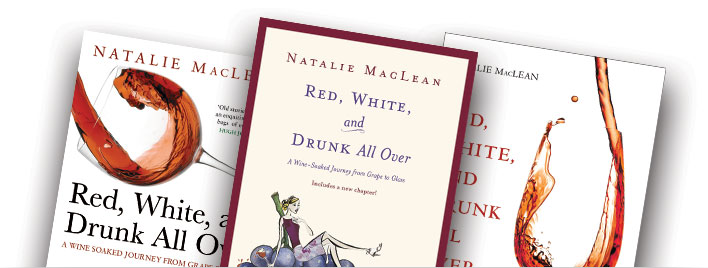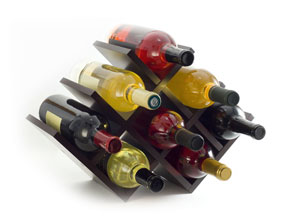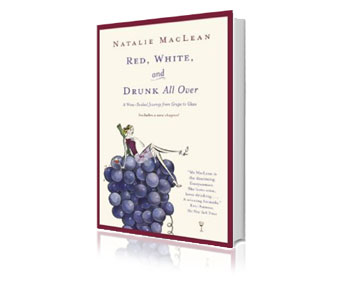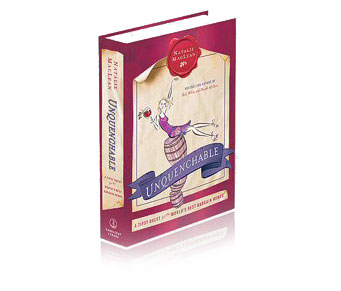Suggestions for Discussion

Book Clubs, Tasting Groups and Wine Courses
I've noted some discussion tips for members of book clubs, tasting groups and wine courses who would like to read Red, White, and Drunk All Over.
If you can suggest other questions, please let me know. If you don't belong to a book club,
but would like to organize one, there are lots of helpful tips here.
I've also included tips on setting up a wine tasting at home, which you may also want to combine with your meeting. And just for fun, I've matched various
books with wines. For a print version of these tips, without graphics, click here.
Chapter 1: The Good Earth
- Describe the difference in taste between wines from the Old World, such as France, Italy, and Spain, and those from the New World, including California, Australia, and Canada? What do you think causes these differences? (Hint: Try a couple of pinot noirs from Burgundy and compare them to pinots from Oregon, New Zealand or Canada.) For wines in stores now, click here.
- What style of wine do you prefer? Do you like a particular region or grape? Why?
- How do you think France, in particular, will have to change its approach to marketing in order to compete more successfully with new wine regions?
Chapter 2: Harvesting Dreams
- Do you think wine is more influenced by the soil and climate or by the winemaker? Why? Is this changing with wines today?
- Which wine regions have you visited that were memorable? Why? Which regions would you like to visit?
- Have you ever dreamed of a career in wine, food, travel or other related fields? Tell us about it.
Chapter 3: The Merry Widows of Mousse
- Describe the difference in taste between bubbly from Champagne, France, and sparkling wines from other regions.
- How well do you think bubbly marries with various dishes, such as oysters, sushi and sashimi, creamy cheeses, salads and vegetarian dishes, and even fried food and potato chips?
- Why do you think women were so successful in running the great champagne houses in the nineteenth and twentieth centuries?
Chapter 4: Purple Prose with a Bite
- What's your view of the role and importance of wine critics? Compare their influence in the world of wine to that of critics in other spheres, such as books, movies, and restaurants. Have you ever dreamed of being a critic in one of these spheres?
- Does it make sense to score wine? Why or why not? Do you see scores as a useful tool when shopping for wine?
- It's been suggested that women are better tasters than men? Do you think this is true? Why or why not?
Chapter 5: A Tale of Two Wine Stores
- Describe the best and worst bottle of wine you've ever bought. The cheapest and most expensive?
- What are the wackiest wine labels you've seen? Do you think these are just gimmicky or do they help to make wine more accessible?
- How could wine be marketed and sold differently?
- Where is you favorite place to buy wine and why?
Chapter 6: A Glass Act
- Describe the difference in taste between wine in a glass designed for it compared to those that aren't or that are too small?
- Why do you think Riedel has been more successful than other glassware makers in marketing its line?
- What are some of the strangest wine descriptions you've read or heard?
Chapter 7: Partners at the Table
- Can you recall a time when a wine and food pairing seemed truly spectacular? A time when one ruined the other? Do you think it's really worthwhile trying to match wine and food?
- Have you ever had any memorable dishes cooked with wine?
- What are the best dinner parties or dinners you've had with friends or colleagues? Why do you remember them?
Chapter 8: Undercover Sommelier
- What have been your best and worst experiences ordering wine in a restaurant?
- What do you think makes for good wine service? Have you ever had a nasty house wine?
- How much should you tip on wine? Does that change for expensive bottles?
Chapter 9: Big City Bacchus
- What have been your most memorable bottles of wine? Why?
- Why do you think we accord wine such special status over other drinks?
- What special bottles do you have in your cellar and when do you plan to drink them?
Overall
- What did you learn about wine from Natalie's book? In what ways has reading it made you feel more confident about wine? What were your favorite and least favorite parts of the book?
- How would you compare her book to others about wine or food in terms of approach, research, voice, style and other aspects?
- How was wine treated when you were growing up? Were you allowed to taste it? Was it forbidden? How has that influenced your consumption of and interest in wine?
- How would you compare your consumption of wine to cocktails? Spirits? Beer? Why are there differences?
If you or your group would like to share your thoughts about Natalie's book after your session, please submit them here.
Hosting an Informal Wine Tasting with Friends
In my book, seven friends come over to my home and we have an informal wine tasting. It's a great excuse to get together and chat about the wines and, as the evening progresses, life in general. You don't need to be a wine expert to host a tasting, just as you don't need to have a doctorate in English literature to organize a book club. In fact, wine tastings work well for book clubs too, especially if you're discussing a book such as Red, White, and Drunk All Over. I've posted lots of low-cost wines in the Wine Picks section of the site for those who want a shopping list for their tasting.
- Invite six to twelve friends - a group size that works well both for the conversation and for dividing a bottle of wine into samples.
- Set the date and time. Around 7 p.m. or 8 p.m. works as you'll need about two to three hours at most.
- Select a theme, such as everyone's most memorable bottle, wines from a certain region such as Australian shiraz or something seasonal, such as champagne during the holidays, sweet wines near Valentine's Day, and so on.
- Determine how much wine you'll serve. A two-ounce pour from eight wines gives everyone a wide sampling without going overboard.
- Choose finger foods that aren't too spicy or hot. These might overwhelm the wine.
- On the evening of the tasting, set out the wine glasses, finger foods, bread, glasses of water, spittoons (mugs are fine) and paper and pens.
- Serve wine in "flights": the first four wines, followed by discussion, and then the second four wines, for example. You may want to keep the bottles in brown bags and number them for a "blind tasting."
- Sample whites before reds, light wines before full-bodied, and dry before sweet.
- Encourage everyone to share their thoughts, which can be as simple as whether they like it or what it reminds them of. At the end, have everyone vote on their favorite wines and then reveal their identities.
- Encourage them to "expectorate" or spit out the wine into their mugs if they choose. Call taxis for those who need one. Set the date for your next tasting.
Matching Wine and Books
What are ten wines to drink with ten classic books?
- Jane Eyre by Charlotte Bronte with California chardonnay
- The Scarlett Letter by Nathaniel Hawthorne with red burgundy (pinot noir)
- War and Peace by Leo Tolstoy with vintage port
- Wuthering Heights by Emily Bronte with British sparkling wine or champagne
- A Tale of Two Cities by Charles Dickens with a southern France cabernet/merlot blend
- Pride and Prejudice by Jane Austen with Chilean chardonnay
- The Grapes of Wrath by John Steinbeck with California zinfandel
- The Great Gatsby by F. Scott Fitzgerald with Washington merlot
- The Catcher in the Rye by J.D. Salinger with cognac (or rye whisky)
- The Good Earth by Pearl Buck with New York riesling
What are ten wines to drink with ten current books?
- DaVinci Code by Dan Brown with Italian chianti
- Eats, Shoots and Leaves by Lynne Truss with New Zealand sauvignon blanc
- The World is Flat by Thomas L. Friedman with Spanish rioja
- The Glass Castle by Jeannette Walls with Canadian riesling
- A Year of Magical Thinking by Joan Didion with South African sauvignon blanc
- Beloved by Toni Morrison with Argentine malbec
- Memoirs of a Geisha by Arthur Golden with sake
- The Tipping Point by Malcolm Gladwell with a German riesling
- The Devil Wears Prada by Lauren Weisberger with Californian cabernet
- Running with Scissors by Augusten Burroughs with Canadian icewine
What are your ten favorite food and wine books to read with any wine?
- The Omnivore's Dilemma by Michael Pollan
- Heat by Bill Buford
- A Year in Provence by Peter Mayle
- Kitchen Confidential by Anthony Bourdain
- The Vineyard: A Memoir by Louisa Thomas Hargrave
- Wine & War by Don & Petie Kladstrup
- The Art of Eating by M.F.K. Fisher
- Comfort Me With Apples by Ruth Riechl
- The Man Who Ate Everything by Jeffrey Steingarten
- The Tummy Trilogy by Calvin Trillin
What are your favorite fun food and wine matches?
- Popcorn with Chilean chardonnay
- Nachos with California zinfandel
- Potato chips with French champagne
- Pizza with Italian chianti
- Fish and chips with German riesling
- Hamburgers with Australian shiraz
- Smoked salmon with Canadian or Oregon pinot noir
- Quiche with New Zealand sauvignon blanc
- Canned brown beans with tawny port
- TV dinner steak with French or Washington cabernet sauvignon
 Best Books of the Year
Best Books of the Year Best Books of the Year
Best Books of the Year

















